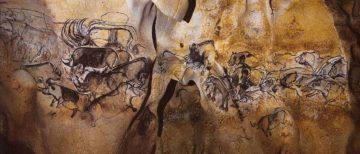by Thomas Larson
 In 1994, Chauvet cave was discovered near the township of Vallon-Pont-d’Arc in southern France. The cave is a spectacular venue for the earliest known rock art made by our ancestors and in no way “primitive.” Deep inside the limestone cavern are hundreds of highly animated wall paintings of bison, bear, ibex, lion, rhinoceros, hyena, wooly mammoth, and horse, “signed” by the red-ochre handprints of the artists. The darkly etched charcoal drawings were sketched in the cave’s smoothed chambers, their walls rounded and pocked from water’s eonic hollowing. In the space are also pudding-like towers of calcium drips, whose conical shapes record the geologic heaping of age. The images, now protected as a World Heritage Site, were done between thirty-thousand and thirty-three thousand years ago.
In 1994, Chauvet cave was discovered near the township of Vallon-Pont-d’Arc in southern France. The cave is a spectacular venue for the earliest known rock art made by our ancestors and in no way “primitive.” Deep inside the limestone cavern are hundreds of highly animated wall paintings of bison, bear, ibex, lion, rhinoceros, hyena, wooly mammoth, and horse, “signed” by the red-ochre handprints of the artists. The darkly etched charcoal drawings were sketched in the cave’s smoothed chambers, their walls rounded and pocked from water’s eonic hollowing. In the space are also pudding-like towers of calcium drips, whose conical shapes record the geologic heaping of age. The images, now protected as a World Heritage Site, were done between thirty-thousand and thirty-three thousand years ago.
In the first ten minutes of Werner Herzog’s Cave of Forgotten Dreams (2011), the film director and his crew hike up a rock face and squeeze through crawls spaces into the cave. Inside, the artists, paleontologists, and filmmakers don hardhats, test flashlights, and review the rules they must follow. The group’s one-hour descent, guarded viewing, and exit are filmed; afterwards, Herzog edits the footage by using two sound guides: the eerie, improvised evocations of cellist-composer Ernst Reijseger, to accompany the images, and Herzog’s voiceover commentary. Like a choirmaster, his soft, German-inflected, baronial English accompanies us through this sonic and architectural marvel. His voice warms and mystifies the claustrophobic space like a nurse talking us through an MRI. Read more »
